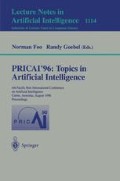Abstract
This paper presents work on an interactive fault diagnosis expert system for telecommunication applications. A new knowledge representation and inference algorithm is proposed to suit the characteristics of the application environment, namely: (1) no parallel event exists in human fault reporting, (2) the diagnostic sequence is unpredictable, and (3) the inference engine is passive in an event-driven environment. A lattice data structure is used for knowledge representation, which is generated automatically from a script of decision rules. The inference engine works in a transaction-like style by prompting and responding to the user according to the knowledge in the lattice. It can explicitly guide the inference sequence, as well as respond to ad hoc input from the user.
Preview
Unable to display preview. Download preview PDF.
References
Aho, A. V. Sethi, R. and Ullman, J. D. (1986) Compilers Principles, Techniques and tools, Reading, Mass: Addison-Wesley.
Berry, D. C. (1994) Involving users in expert system development, Expert Systems, 11(1), 23–28.
Dumas, J. S. (1988) Designing User Interfaces for Software, Prentice Hall.
Forgy, C. L. (1982) Rete: a fast algorithm for the many pattern/many object pattern match problem, Artificial Intelligence, 19(1), 17–27.
McLaughlin, L. and Christie, R. D. (1994) Are expert system rules really easier to modify?, International Journal of Engineering Intelligent Systems for Electrical Engineering and Communications, 2(4), 263–272.
Sassen, J. M. A. Buiel, E. F. T. and Hoegee, J. H. (1994) A laboratory evaluation of a human operator support system, International Journal of Human-Computer Studies, 40, 895–931.
Suh, C. K. and Suh, E H. (1993) Using human factor guidelines for developing expert systems, Expert Systems, 10(3), 151–156.
Vale, A. A. Goncalves, M. J. and Vale, Z. A. (1992) Improving Man-machine interaction in control centres, IEEE Power Engineering Society 1992 Summer Meeting, SM 602-3, USA.
Author information
Authors and Affiliations
Editor information
Rights and permissions
Copyright information
© 1996 Springer-Verlag Berlin Heidelberg
About this paper
Cite this paper
Zhao, M., Leckie, C. (1996). The development of an interactive fault diagnosis expert system for telecommunication applications. In: Foo, N., Goebel, R. (eds) PRICAI'96: Topics in Artificial Intelligence. PRICAI 1996. Lecture Notes in Computer Science, vol 1114. Springer, Berlin, Heidelberg. https://doi.org/10.1007/3-540-61532-6_6
Download citation
DOI: https://doi.org/10.1007/3-540-61532-6_6
Published:
Publisher Name: Springer, Berlin, Heidelberg
Print ISBN: 978-3-540-61532-3
Online ISBN: 978-3-540-68729-0
eBook Packages: Springer Book Archive

